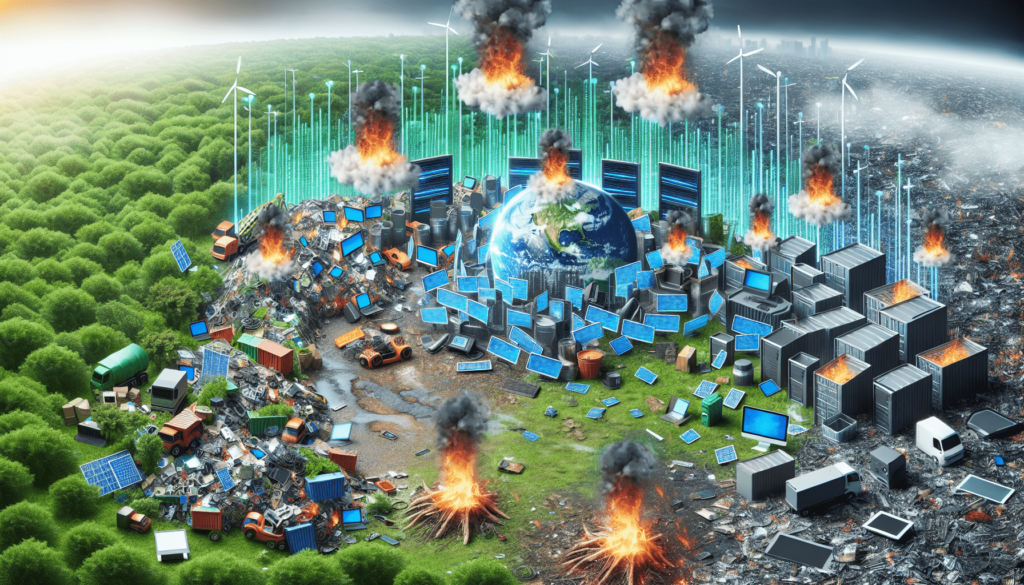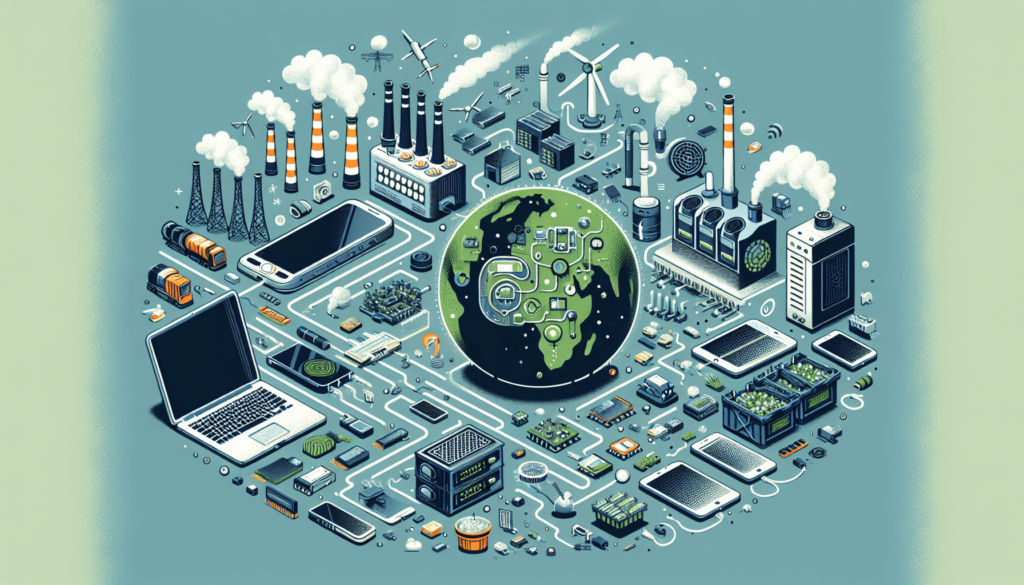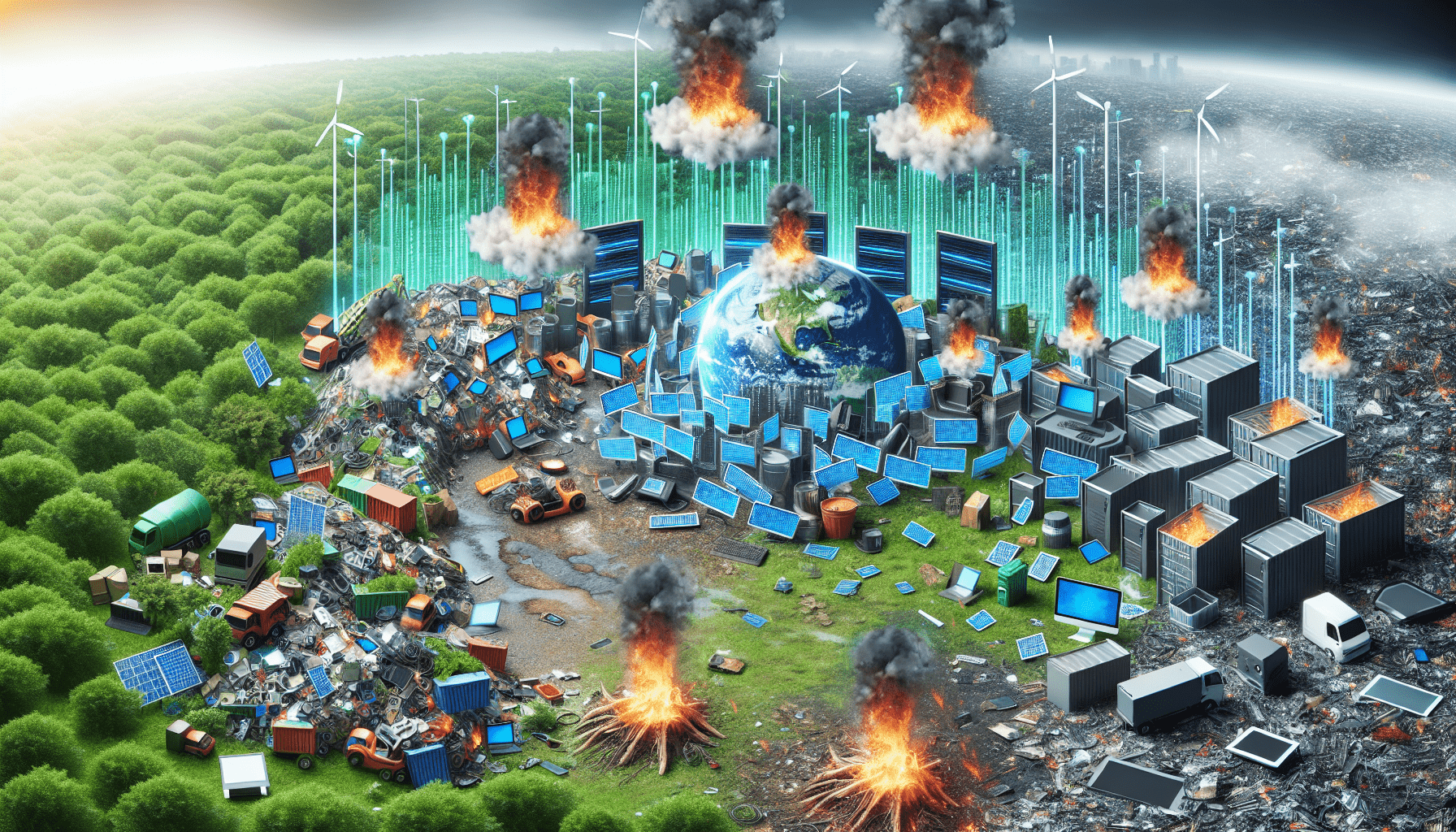Imagine a world where digital technologies are not only transforming our lives but also our planet. As we spend more time on our smartphones, computers, and other devices, it’s crucial to be aware of the environmental impact they have. From the production and disposal of electronic devices to the energy consumption of data centers, every aspect of our digital lifestyles leaves a footprint on the Earth. In this article, we will explore the various ways that digital technologies contribute to environmental change and what steps we can take to minimize our impact. So, grab your eco-friendly cup of coffee and let’s delve into the fascinating world of the environmental impact of digital technologies.

Energy Consumption
Power Consumption of Data Centers
Data centers are essential for the storage, processing, and distribution of vast amounts of digital data. However, the operation of these data centers requires a significant amount of energy. With the increasing popularity of cloud computing, the energy consumption of data centers has surged. These facilities constantly require power to operate the servers, cooling systems, and other necessary equipment. This high power demand contributes to a substantial carbon footprint and places a strain on global energy resources.
Energy Usage of Electronic Devices
In our increasingly digitized world, electronic devices play a crucial role in our daily lives. However, it’s important to recognize the energy consumption associated with these devices. From smartphones and laptops to televisions and household appliances, electronic devices require energy to function. Charging these devices, running them, and powering their components all contribute to the overall energy usage. As the number of devices continues to rise, so does the energy consumption, further impacting our environment.
Carbon Footprint of Internet Usage
Internet usage has become an integral part of modern society, connecting people across the globe and providing access to information and services. However, the carbon footprint associated with internet usage is often overlooked. Data transmission, storage, and processing all require energy, which in turn leads to carbon emissions. The vast amount of data being transmitted globally contributes to the carbon footprint, making it essential to consider the environmental impact of our online activities.
E-waste Generation
Obsolete Electronics and Gadgets
As technology rapidly evolves, electronic devices and gadgets become outdated and are often replaced with newer models. This constant upgrade cycle leads to a significant generation of e-waste. Old smartphones, computers, and other electronic devices end up discarded, contributing to the growing e-waste problem. These obsolete devices not only contribute to environmental pollution but also waste valuable resources that were utilized in their production.
Improper Disposal and Recycling
One of the major challenges in e-waste management is the improper disposal and recycling of electronic devices. Many people are unaware of the proper methods for disposing of e-waste, leading to devices ending up in landfills or being incinerated. Improper disposal not only leads to the loss of valuable resources but also poses a threat to human health and the environment due to the release of toxic substances. It is crucial to educate and promote responsible e-waste disposal and recycling practices.
Toxic Substances Leaching into the Environment
Electronic devices contain various toxic substances, such as lead, mercury, and brominated flame retardants, which can leach into the environment if not properly managed. When e-waste is not handled appropriately, these toxic substances can contaminate soil, water, and air, posing risks to ecosystems and human health. The disposal of e-waste in landfills or the burning of e-waste release these toxins, making it essential to manage e-waste in a way that prevents their release and reduces environmental pollution.
Mining of Minerals
Extraction of Rare Earth Metals
The production of electronic devices requires a significant amount of rare earth metals, which are predominantly mined in environmentally sensitive areas. The extraction of these metals often involves destructive mining practices that lead to deforestation, habitat destruction, and ecosystem disruption. As the demand for electronic devices continues to rise, the mining of rare earth metals intensifies, further exacerbating the environmental impact.
Deforestation and Habitat Destruction
The mining of minerals for electronic devices often leads to deforestation and habitat destruction. The extraction of minerals requires clearing large areas of land, leading to the displacement of wildlife and destruction of ecosystems. This loss of habitat poses a threat to biodiversity and exacerbates climate change as trees play a crucial role in carbon sequestration. It is essential to explore sustainable mining practices and reduce the environmental impact of mineral extraction.
Water and Soil Pollution
Mining activities for electronic device production can result in significant water and soil pollution. The extraction process often involves the use of chemicals and the generation of toxic mine tailings, which can contaminate water sources and impair soil quality. This pollution not only poses risks to human health but also affects aquatic ecosystems and agricultural productivity. Implementing stringent regulations and technologies to minimize water and soil pollution is crucial in reducing the environmental impact of mineral extraction.
Material Consumption
Manufacturing of Electronic Devices
The manufacturing process of electronic devices requires the utilization of various materials, including metals, plastics, and chemicals. The extraction and processing of these materials contribute to resource depletion and environmental degradation. Additionally, energy-intensive manufacturing processes further contribute to greenhouse gas emissions and energy consumption. It is important to consider sustainable manufacturing practices and the use of recycled or eco-friendly materials to mitigate the environmental impact of electronic device production.
Resource Depletion
The production of electronic devices relies heavily on the extraction of finite resources, such as metals like gold, silver, and copper. The increasing demand for these resources for electronics manufacturing contributes to resource depletion, as well as the destruction of natural habitats and ecosystems. To address resource depletion, it is crucial to promote recycling and the use of recycled materials in the production of electronic devices, reducing the reliance on virgin resources.
Packaging Waste
Electronic devices often come with excessive packaging, leading to significant amounts of waste. Packaging materials, such as plastic, cardboard, and foam, contribute to the overall environmental footprint of electronic devices. The production, transportation, and disposal of packaging materials further contribute to energy consumption and carbon emissions. Implementing sustainable packaging practices, such as reducing packaging materials and utilizing eco-friendly alternatives, can significantly minimize the environmental impact of electronic device packaging.

Electronic Pollution
Electronic Waste Burning
Improper disposal of e-waste sometimes involves burning, which releases toxic fumes and pollutants into the atmosphere. Burning electronic waste not only contributes to air pollution but also releases harmful chemicals, such as dioxins and furans, which have adverse effects on both human health and the environment. Proper e-waste management, including responsible recycling and disposal, is essential to prevent the harmful consequences of e-waste burning.
Air Pollution from Manufacturing Processes
The manufacturing of electronic devices involves various industrial processes that can release harmful pollutants into the air. These processes often emit volatile organic compounds (VOCs), particulate matter, and greenhouse gases. The released pollutants contribute to air pollution and have detrimental effects on air quality and human health. Implementing technologies and practices that minimize emissions and promote cleaner manufacturing processes can help mitigate the air pollution associated with electronic device production.
Chemical Pollution from Production
The production of electronic devices requires the use of chemicals, such as solvents, cleaning agents, and flame retardants. Improper handling and disposal of these chemicals during the manufacturing process can lead to chemical pollution. Chemical pollutants, when released into the environment, can contaminate water sources, soil, and air, posing risks to ecosystems and human health. Implementing strict regulations and enforcing responsible chemical management practices are crucial steps in minimizing chemical pollution from electronic device production.
Water Usage
Water Consumption in Data Centers
Data centers, which are essential for digital infrastructure, consume significant amounts of water for cooling purposes and other operational needs. The cooling systems in data centers often rely on water-intensive processes, requiring large volumes of water. The high water consumption in data centers can strain local water sources and contribute to water scarcity, especially in areas already facing water stress. Developing water-efficient cooling technologies and implementing water conservation practices in data centers are essential in reducing their water footprint.
Impacts on Local Water Sources
The extraction and processing of minerals for electronic devices can have significant impacts on local water sources. These mining activities often require large amounts of water, leading to the depletion of local water sources and disruption of aquatic ecosystems. The pollution resulting from mining operations can contaminate water sources, further exacerbating the environmental impact. Implementing responsible mining practices and promoting water conservation efforts are crucial in protecting local water sources and mitigating the impacts of electronic device production.
Contamination from Electronic Waste Recycling
The recycling of electronic waste, while an important step in reducing e-waste, can also pose risks to water sources. Improper recycling practices or inadequate waste management systems can lead to the leaching of toxic substances from e-waste into water sources. This contamination can have detrimental effects on aquatic ecosystems, as well as on the communities that rely on these water sources for drinking or irrigation purposes. Proper regulation and enforcement of e-waste recycling practices are crucial in preventing water contamination and ensuring proper treatment of wastewater from recycling facilities.
Global Carbon Footprint
Greenhouse Gas Emissions from Data Centers
Data centers contribute to the global carbon footprint through their energy consumption and emissions. The electricity required to power data center operations often comes from fossil fuel sources, resulting in the release of greenhouse gases, such as carbon dioxide. Additionally, the cooling systems in data centers contribute to energy consumption, further increasing carbon emissions. To reduce the carbon footprint of data centers, transitioning to renewable energy sources and implementing energy-efficient technologies are crucial steps.
Transportation Emissions for Electronics
The transportation of electronic devices from manufacturing facilities to end-users or retail stores contributes to carbon emissions. The global supply chains for electronic devices often involve long-distance transportation, leading to significant emissions from trucks, ships, and airplanes. Reducing transportation emissions can be achieved through localized manufacturing, optimizing logistics, and promoting sustainable transportation methods, such as rail or electric vehicles. These measures can help reduce the carbon footprint associated with the transportation of electronic devices.
Lifecycle Assessments of Digital Systems
Considering the entire lifecycle of digital systems is essential in understanding their carbon footprint. From the extraction of raw materials to the production, use, and disposal of electronic devices, each stage contributes to greenhouse gas emissions. Conducting lifecycle assessments allows for a comprehensive evaluation of the environmental impacts of digital technologies and enables targeted strategies for reducing their carbon footprint. By implementing sustainable design, improving energy efficiency, and prioritizing recycling and responsible disposal, the overall carbon footprint of digital systems can be effectively reduced.
Digital Divide
E-waste Disposal Disparities
The digital divide refers to the gap in access to and use of digital technologies between different regions and socioeconomic groups. This divide also extends to the disposal of e-waste, with certain regions and communities having limited resources or infrastructure for proper e-waste management. Disparities in e-waste disposal practices can lead to increased environmental pollution in marginalized areas, where improper recycling or disposal may occur. Bridging the digital divide includes addressing e-waste disposal disparities and ensuring equitable access to responsible recycling facilities for all communities.
Unequal Access to Technology
Unequal access to technology is a significant concern in terms of environmental impact. Regions or communities with limited access to digital technologies may face challenges in implementing sustainable practices, such as energy-efficient devices or responsible e-waste management. Unequal access perpetuates the consumption of energy-inefficient devices and the improper disposal of e-waste, resulting in increased environmental degradation. Bridging the digital divide requires addressing inequalities in technology access to promote sustainable development globally.
Implications for Sustainable Development
Promoting sustainable development requires considering the implications of digital technologies on environmental and social aspects. While digital technologies offer numerous opportunities for progress, the negative environmental impact can hinder sustainable development efforts. Bridging the digital divide and ensuring equitable access to technology, coupled with sustainable practices and responsible consumption, can promote more inclusive and sustainable development worldwide. By harnessing the power of digital technologies while minimizing their environmental impact, we can work towards a more sustainable future for all.
Sustainable Solutions
Energy-efficient Data Centers
Developing and implementing energy-efficient technologies and practices in data centers is crucial in reducing their environmental impact. This includes optimizing server efficiency, cooling systems, and power usage effectiveness (PUE). By employing energy-saving strategies such as virtualization, server consolidation, and advanced cooling techniques, data centers can significantly reduce their energy consumption and carbon footprint.
Circular Economy for Electronics
Transitioning towards a circular economy for electronics can significantly reduce the environmental impact of electronic devices. This involves designing products with longevity and ease of repair in mind, promoting reuse and refurbishment, and ensuring responsible recycling of materials at the end of the device’s life. By extending the lifespan of electronic devices and creating closed-loop material cycles, the extraction of raw materials can be minimized, reducing resource depletion and environmental degradation.
Promoting E-waste Recycling and Responsible Consumption
Educating consumers about the importance of responsible e-waste recycling and encouraging sustainable consumption practices is crucial in mitigating the environmental impact of electronic devices. Implementing producer responsibility programs, where manufacturers take responsibility for the end-of-life disposal and recycling of their products, can help promote proper e-waste management. Additionally, making information about the environmental impact of electronic devices readily available to consumers can empower them to make more sustainable choices.
Policy and Regulations
International Agreements on E-waste Management
International agreements and frameworks play a vital role in addressing the environmental impact of digital technologies. Agreements such as the Basel Convention on the Control of Transboundary Movements of Hazardous Wastes and their Disposal aim to regulate the transboundary movement of e-waste and promote environmentally sound management. Collaborative efforts among governments, industry stakeholders, and environmental organizations are crucial in developing and implementing effective policies and regulations for e-waste management at the global level.
Energy Efficiency Standards for Digital Devices
Setting energy efficiency standards and regulations for digital devices can help reduce their overall energy consumption. Governments and regulatory bodies can establish mandatory efficiency requirements for electronic devices, encouraging manufacturers to develop more energy-efficient products. These standards can drive innovation in energy-saving technologies and incentivize consumers to choose energy-efficient devices, ultimately reducing carbon emissions and saving energy.
Laws Encouraging Sustainable Practices in the Technology Industry
Enforcing laws that encourage sustainable practices in the technology industry can significantly reduce its environmental impact. Governments can implement regulations that promote eco-design and eco-labeling, ensuring that electronic devices meet certain sustainability criteria. Additionally, tax incentives or subsidies can be provided to manufacturers and consumers who adopt sustainable practices, such as energy-efficient technologies and responsible e-waste management. By holding the technology industry accountable and incentivizing sustainable practices, environmental degradation can be minimized and a more sustainable future can be realized.
In conclusion, the environmental impact of digital technologies encompasses various aspects, from energy consumption and e-waste generation to mining practices and pollution. Recognizing the environmental consequences and actively implementing sustainable solutions, policies, and regulations is essential to minimize the footprint of digital technologies. By promoting energy efficiency, responsible e-waste management, and equitable access to technology, we can embark on a path towards sustainable development and a greener future.

